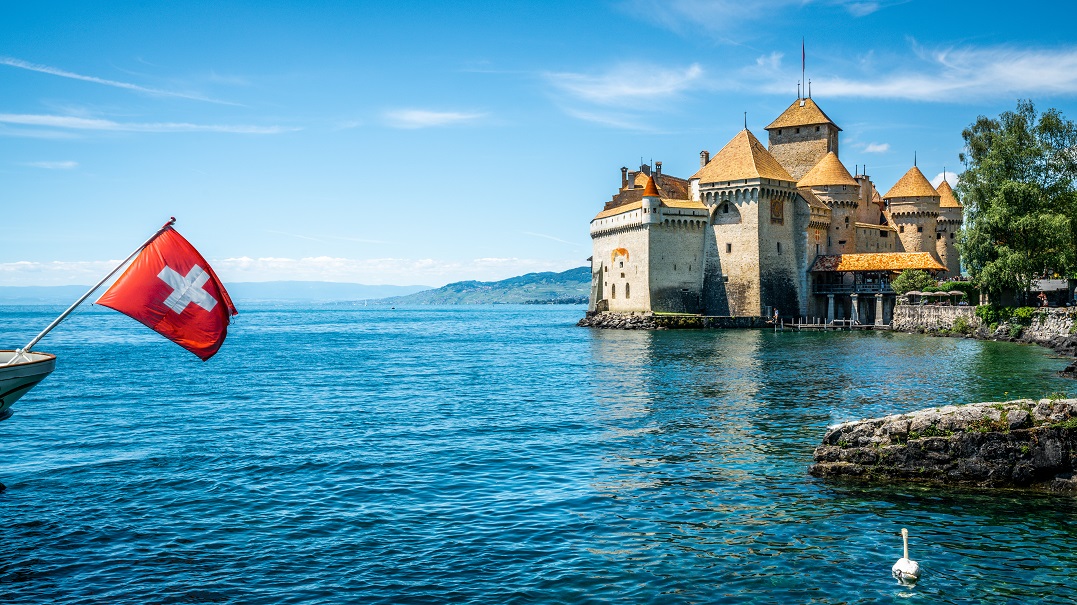6 castles in Switzerland absolutely worth a visit
Published on June 15, 2023 / Updated on July 6, 2023
When it comes to touristic appeal, Switzerland is first and foremost known for its natural beauty, from breathtaking mountains to gorgeous lakes. But those impressive geographical features are often adorned with equally impressive castles, adding a bit of culture and history to any road trip through Switzerland.
The strategic location of these Swiss castles isn’t an accident of luck. These century-old monuments were often used as fortresses to control traffic and to protect their residents from attacks. Nowadays, many castles in Switzerland gladly welcome visitors, inviting them in to explore the past and enjoy the view. If you’re pondering which castle to visit on your next bank holiday, find inspiration with our list of the six most popular and famous castles in Switzerland.
Alongside Castelgrande and Sasso Corbaro, Castello di Montebello is part of the fortifications of the city of Bellinzona. Their strategic positions once helped to control passage from the valley of the Ticino River and through the San Gothard pass.
Construction on the Castello di Montebello started in the 14th century and the completed castle now ranks among the most refined examples of late-medieval fortified architecture in the Alps. Its position at the top of the hills of Bellinzona provides amazing views of the city and surrounding landscapes.
The castle is also a family-friendly site, with a pleasant picnic area and a well-equipped playground. Inside, you can visit the Civic Museum, which contains many archeological artifacts from local prehistoric burial sites.
The Château de Chillon is not only the biggest castle in Switzerland; it’s also the most visited, with over 400,000 guests every year.
It’s not hard to see why. This medieval castle sits on a tiny rocky island just off the eastern end of Lake Geneva. Its strategic position made it a perfect stronghold for the Counts of Savoy to control traffic on the lake from the 12th until the 16th century. The fortress was also used as a state prison. Today, you can spend several hours exploring its courtyards and its rooms full of artifacts.
Gruyère is not just a famous cheese that regularly features in Swiss dishes. If you add an s to the name, you get the castle of Gruyères. Shaped as a carré Savoyard, a squarish military design invented by the House of Savoy, the fortress consists of a keep and several towers. Built in the 13th century, it was the primary residence of the counts of Gruyères for several centuries.
The Canton of Fribourg — one of the three bilingual cantons of Switzerland, with both German and French as official languages — bought the property in 1938 and turned it into a museum open to the public. With magnificent collections that include medieval stained glass and the beautifully decorated Knight’s Room, visitors are invited to travel through eight centuries of regional history, culture and architecture.
Fancy a bit of a break from one of the busiest Swiss cities without having to travel too far? Rapperswil Castle may just be what you’re looking for! Tucked away at a quiet end of Lake Zurich about 25 miles away from the city, it sits atop a steep, rocky hill called Lindenhof. There, you can enjoy views of the old town of Rapperswil, as well as of the harbor, the lake and the Alps in the distance.
Dating back to the 12th century, the castle fell into disrepair before being leased to Count Władysław Broel-Plater in 1870. The Polish emigrant restored it to its medieval majesty and made it the home of the Polish National Museum, which you can still visit today. It’s the perfect opportunity to see the interiors of the castle, from the dungeons to the staterooms.
Built in 933, Spiez Castle is one of the oldest castles in Switzerland. Today, its museum hosts a permanent exhibition to tell the long history of the castle, as well as some other temporary exhibitions.
Spiez Castle also benefits from an idyllic location, with vineyards all around and the Alps as a backdrop. If you have the time, make sure you climb to the top of the castle tower to enjoy the amazing views of Lake Thun.
Standing proudly atop a rocky peak overlooking the city of Sion, Tourbillon Castle is not for the faint-hearted. You’ll need to climb a steep staircase in order to access it. But it’s all worth the effort, as you’ll be rewarded with wonderful views, including that of the Basilique de Valère which stands on the opposite hill.
Built in the 13th century, Tourbillon Castle was once the residence of the Bishop of Sion. But a fire in 1788 laid it to ruin, and only a 15th-century chapel, the rectangular keep and a watchtower have survived.
The six names in our list are definitely not the only castles in Switzerland. But they’re among the most beautiful and most popular. They all come in different shapes, sizes and locations. But each is a testament to the long history of the country, which dates back to medieval times and beyond. Go explore them and feel like royalty for a day!
